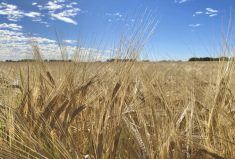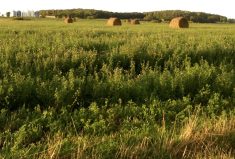Feed barley has some tough competition. Once the second-largest crop by far on the Prairies, in recent years it’s had to compete for acres with canola and pulses. And while malting premiums are still tempting some growers, feed barley has to compete with cheap U.S. corn and corn gluten.
As for the formerly touted qualities of barley-fed pork, feeders have had to cut rations because barley and hogs are both susceptible to fusarium.
Consequently, over the last 20 years annual Prairie barley area has dropped by about half to roughly six million acres, about half of which is in Alberta.
Read Also

Agronomists share tips for evaluating new crop products and tech: Pt. 3
With new products, new production practices and new technology converging on the agriculture industry at a frenetic pace in recent…
Now, has it stabilized, or is feed barley still in decline?
Still a staple ration
Across the Prairies, feed barley is still the cornerstone of most feed regimens.
In Alberta, an estimated 60 per cent of varieties planted are feed varieties and 40 per cent are malting barley varieties, according to Alberta Barley, the provincial promotion organization. Nearly two million acres were planted to feed barley varieties in 2015.
In Saskatchewan, 2.7 million tonnes of barley were grown in 2015. “Roughly 70 to 80 per cent of that we estimate to be feed barley,” says Brent Johnson, vice-chair of Sask Barley and chair of the organization’s feed barley committee.
Most of Manitoba’s acreage consists of malting varieties, but there’s momentum in the province to discourage competition from U.S. corn, says Manitoba Wheat and Barley Growers Association chair Fred Greig.
“Anything we can do as producers to displace other countries’ grain from our market, we for sure want to do,” says Greig.
Breeding priorities
Most feed barley varieties are still much higher yielding than malting varieties, says Aaron Beattie, barley breeder at the University of Saskatchewan’s Crop Development Centre.
Feed barley is attractive to producers thanks in large part to good genetics, and Beattie’s team is ahead of the curve in breeding new varieties with strong agronomic qualities and disease resistance.
“When we think about feed barley we have a couple of main objectives in mind in terms of characteristics we’re trying to incorporate into those varieties — high yield is of primary importance, and good lodging resistance to ease harvest operations,” he says. “We’re also going for really high test weight in those samples and trying to incorporate some good disease resistance.”
Beattie’s program is responsible for some of the most widely grown varieties in Western Canada, including two-row varieties CDC Austenson and Xena — the former is prized for high yields and test weights, the latter for its good fusarium head blight tolerance.
Beattie says there are new feed barley varieties in the variety registration trial process right now, one of which has shown better fusarium tolerance than Xena, although more data is needed before the “resistant” label can be formally applied.
In Western Canada, because any variety can be used for feed, Beattie’s program uses two tactics in its approach to breeding feed barley. The first is to make specific crosses for feed-type barley, while the second makes use of existing breeding resources.
“We also have varieties that are initially intended for malting, and if they have good agronomics but lack malt quality they’re perfectly suitable for feed barley,” Beattie explains.
Although the yield of malting varieties is catching up to feed types, Beattie says he’d still give an edge to feed varieties when it comes to lodging.
Asian exports?
Domestic demand might be on a gradual decline, but there’s some evidence that new export markets could be opening.
Beattie says Canadian feed barley is prized in China for its naturally high protein levels (often 12 per cent and higher) compared to Australian feed barley, where protein levels can often drop below 10 per cent.
Johnson says feed barley is attractive to Asian markets because barley-finished pork has superior fat quality. SaskBarley is putting research into whether the same principle translates to barley-fed beef.
The organization is also interested in health benefits of barley for both animal and human consumption. “There is work in hogs showing that feed barley has use as a pre-biotic, reducing antibiotic use,” Johnson says. A large body of research also points to its health benefits for human consumption.
For the present, the feed barley market is still healthy in Western Canada — but the jury is still out on the future.
“I think feed barley will remain the main feed grain in Western Canada but U.S. corn will limit any upside and keep the market under pressure. And with increased wheat feeding we’ll see a slight year-over-year decline in domestic consumption for feed barley,” says Jerry Klassen, manager of the Canadian office for Swiss-based grain trader GAP SA Grains & Produits Ltd. Klassen is also a long-time feed grain and livestock market analyst.
Last August, Klassen was hoping the 2016 crop would come off well, with trade estimates between about 8.2 and nine million tonnes.
Feed prices in the major feeding region of southern Alberta were about $170/tonne delivered to the feedlot in mid-August, though those numbers had dropped to $130/tonne in Saskatoon. In Manitoba, feed barley prices were hovering around $175/tonne, close to corn, and demand had dropped overall.
Klassen said the western Canadian hog complex, along with the cattle herd, has remained stagnant or dropped slightly in numbers since 2010 — and with it, feed barley demand. Through the fall, the feed barley market was under pressure in Western Canada due to seasonally low cattle-on-feed numbers and aggressive farmer selling of old-crop supplies. For 2016-17, the industry is anticipating a year-over-year increase in domestic feed wheat usage along with potential imports of U.S. corn and corn gluten, he said. Alternative feed grains will displace barley in feedlot rations.
















